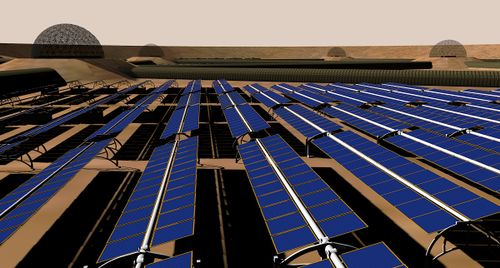Difference between revisions of "Cost of energy on Mars"
| Line 5: | Line 5: | ||
There can be no absolute answer to this question, as the cost of energy will vary depending on the source and the level of development of the colony. If all the energy producing equipment comes from Earth, the cost will be higher than if it is produced [[In-situ resource utilization|in-situ]]. As the settlement grows larger, economies of scale will come into play to reduce energy costs. As automation increases, and productivity increases accordingly, the cost of energy may go down significantly. Self replication of production equipment may eventually bring down the cost of energy to very small values. This will allow the realization of projects using energy on a scale that will be, literally, cosmic. | There can be no absolute answer to this question, as the cost of energy will vary depending on the source and the level of development of the colony. If all the energy producing equipment comes from Earth, the cost will be higher than if it is produced [[In-situ resource utilization|in-situ]]. As the settlement grows larger, economies of scale will come into play to reduce energy costs. As automation increases, and productivity increases accordingly, the cost of energy may go down significantly. Self replication of production equipment may eventually bring down the cost of energy to very small values. This will allow the realization of projects using energy on a scale that will be, literally, cosmic. | ||
| − | But before such a grand time comes, we can estimate a preliminary value for the cost of solar energy on Mars for a growing settlement of a few hundred to a few thousand settlers. | + | But before such a grand time comes, we can estimate a preliminary value for the cost of solar energy on Mars for a growing settlement of a few hundred to a few thousand settlers. |
==Solar energy== | ==Solar energy== | ||
| + | For this estimation we will use a solar panel array built on Earth with the following characteristics: | ||
| + | {| class="wikitable" | ||
| + | |+Solar array characteristics | ||
| + | !Characterisitic | ||
| + | ! | ||
| + | !References | ||
| + | ! | ||
| + | |- | ||
| + | |Efficiency | ||
| + | |30% | ||
| + | |This would require fairly expensive multijunction production cells. Large volumes of production would keep the cost low. | ||
| + | | | ||
| + | |- | ||
| + | |Mass | ||
| + | |3,5 kg/m2 | ||
| + | |This is the NASA 2018 BIG challenge target of 3 kg/m2, plus 0,5 kg/m2 for ancillary equipment | ||
| + | | | ||
| + | |- | ||
| + | |Cost on Earth | ||
| + | |800 $/m2 | ||
| + | |An estimate based on an average cost of 500$/m2 for conventional panels on Earth | ||
| + | | | ||
| + | |} | ||
| + | Transported by SpaceX Starship with other cargo and unfolded on Mars semi-autonomously. | ||
| + | |||
| + | For the [[Cost of transportation|Cost of Transportation]] to Mars, we simply use the cost proposed by SpaceX for their transportation system, 500$ per kg to Mars. | ||
| + | |||
| + | Solar panel design | ||
| + | |||
| + | Solar panel energy | ||
==Nuclear energy== | ==Nuclear energy== | ||
Revision as of 07:29, 22 April 2019
The cost of energy on Mars is one of the prime parameters required to analyse martian settlement scenarios. To go beyond generalizations and actually evaluate one scenario against another, the cost of energy and the cost of transportation to and from Mars need to be known, or at least estimated to compare on a common basis.
There can be no absolute answer to this question, as the cost of energy will vary depending on the source and the level of development of the colony. If all the energy producing equipment comes from Earth, the cost will be higher than if it is produced in-situ. As the settlement grows larger, economies of scale will come into play to reduce energy costs. As automation increases, and productivity increases accordingly, the cost of energy may go down significantly. Self replication of production equipment may eventually bring down the cost of energy to very small values. This will allow the realization of projects using energy on a scale that will be, literally, cosmic.
But before such a grand time comes, we can estimate a preliminary value for the cost of solar energy on Mars for a growing settlement of a few hundred to a few thousand settlers.
Solar energy
For this estimation we will use a solar panel array built on Earth with the following characteristics:
| Characterisitic | References | ||
|---|---|---|---|
| Efficiency | 30% | This would require fairly expensive multijunction production cells. Large volumes of production would keep the cost low. | |
| Mass | 3,5 kg/m2 | This is the NASA 2018 BIG challenge target of 3 kg/m2, plus 0,5 kg/m2 for ancillary equipment | |
| Cost on Earth | 800 $/m2 | An estimate based on an average cost of 500$/m2 for conventional panels on Earth |
Transported by SpaceX Starship with other cargo and unfolded on Mars semi-autonomously.
For the Cost of Transportation to Mars, we simply use the cost proposed by SpaceX for their transportation system, 500$ per kg to Mars.
Solar panel design
Solar panel energy







